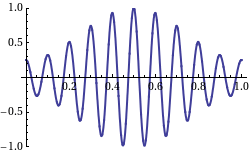Wave
A wave is the motion of a field that oscillates at one point and oscillation propagates to neighboring points.
It could be shown that the equation of motion of a point in a wave satisfied the wave equation
$$\frac{1}{v^2}\frac{\partial^2 u}{\partial t^2} = \frac{\partial^2 u}{\partial x^2}$$
Consider two points on the wave with \(2\pi\) phase difference (1 cycle) at time \(t\). Define their distance \(\lambda\) as the wavelength. \begin{align} (kx' - \omega t + \phi) - (kx - \omega t + \phi) &= 2 \pi \\ k(x' - x) = k\lambda &= 2\pi \\ k &= \frac{2\pi}{\lambda} \end{align} \(k\) is called the wavenumber.
Consider the same point on the wave \(x\) after 1 cycle of time. Define this time interval \(T\) as period and its inverse \(f = \frac{1}{T}\) as frequency. \begin{align} (kx - \omega t' + \phi) - (kx - \omega t + \phi) &= 2\pi \\ \omega T &= 2\pi \\ \omega = \frac{2\pi}{T} &= 2\pi f \end{align} \(\omega\) is called the angular frequency.
Consider a point on the wave at \(x\) at time \(t\) with a particular phase \(\phi'\). After time \(t'\) its neighboring point \(x'\) has the same phase \(\phi'\). \begin{align} (kx' - \omega t' + \phi) - (kx - \omega t + \phi) &= \phi' - \phi' \\ k\Delta x &= \omega \Delta t \\ v_p \equiv \frac{\Delta x}{\Delta t} &= \frac{\omega}{k} = \lambda f \end{align} \(v_p\) is called the phase velocity. It measures the direction and the speed of the phase of the wave propagates.
Wave Properties
The general solution of the wave equation is $$u(x, t) = A\sin(kx - \omega t + \phi)$$ \(A\) is the amplitude of the wave which indicates the highest point can reach from equilibrium. \(\phi\) is the phase constant. It is used to satisfy the initial condition only.Consider two points on the wave with \(2\pi\) phase difference (1 cycle) at time \(t\). Define their distance \(\lambda\) as the wavelength. \begin{align} (kx' - \omega t + \phi) - (kx - \omega t + \phi) &= 2 \pi \\ k(x' - x) = k\lambda &= 2\pi \\ k &= \frac{2\pi}{\lambda} \end{align} \(k\) is called the wavenumber.
Consider the same point on the wave \(x\) after 1 cycle of time. Define this time interval \(T\) as period and its inverse \(f = \frac{1}{T}\) as frequency. \begin{align} (kx - \omega t' + \phi) - (kx - \omega t + \phi) &= 2\pi \\ \omega T &= 2\pi \\ \omega = \frac{2\pi}{T} &= 2\pi f \end{align} \(\omega\) is called the angular frequency.
Consider a point on the wave at \(x\) at time \(t\) with a particular phase \(\phi'\). After time \(t'\) its neighboring point \(x'\) has the same phase \(\phi'\). \begin{align} (kx' - \omega t' + \phi) - (kx - \omega t + \phi) &= \phi' - \phi' \\ k\Delta x &= \omega \Delta t \\ v_p \equiv \frac{\Delta x}{\Delta t} &= \frac{\omega}{k} = \lambda f \end{align} \(v_p\) is called the phase velocity. It measures the direction and the speed of the phase of the wave propagates.



Comments
Post a Comment